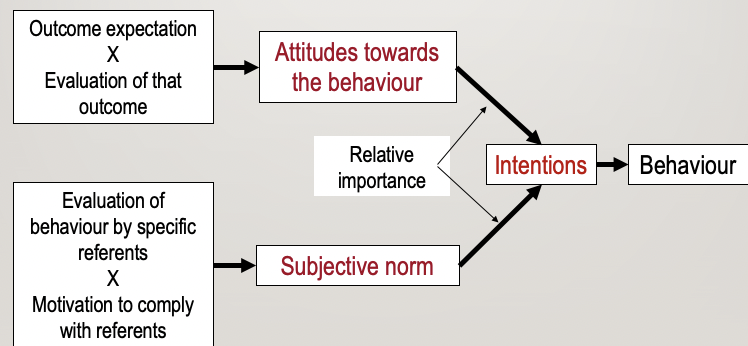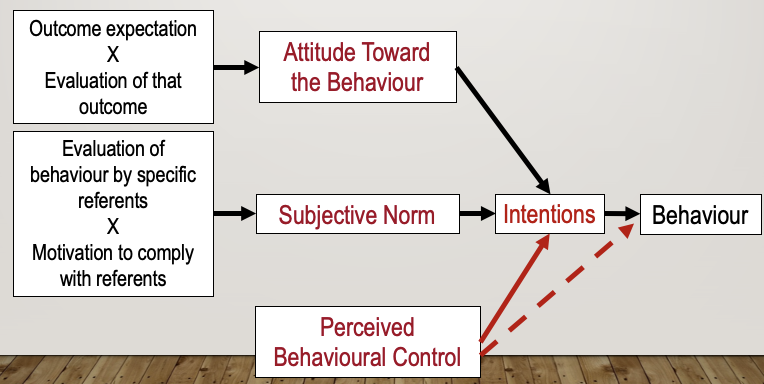15C (LaPiere: hospitality study, 1934)
1/22
There's no tags or description
Looks like no tags are added yet.
Name | Mastery | Learn | Test | Matching | Spaced |
|---|
No study sessions yet.
23 Terms
Background- what did LaPiere believe attitudes were
attitudes were actions
did this mean we can measure actions by asking people about their attitudes?
the study he did to see if behaviour predicted attitudes
common assumption was attitudes predict behaviour
asked french and english if they would:
let a good black person live in their home
admit a non-white guest to their hotel
findings:
french- around 70% for both
english- 20% for both conditions
what did LaPiere comment upon
disagreed with the common assumption and suggested:
questionnaires rests on the unproven assumption that there is a simple link between the symbolic (verbal) and non-symbolic (behavioural) response to an attitude object
extension
wanted to know if these different attitudes align with hotel policies
assumption: hotel policies tend to reflect the public opinion
findings: more policies in the UK excluded non-whites than France
criticism: asking people and looking at hotel policies are only symbolic representations, none measure actions
The study- social context at the time
US attitudes to Chinese in the 1930's
Chinese immigration restricted
Chinese are barred from landownership
Intermarriage with other races such as Chinese forbidden
Strong stereotypes against Chinese immigrants
Depiction of Chinese in movies as untrustworthy characters
method
1930-1932- LaPiere travelled across the US with a young Chinese couple
visited 251 establishments
67 hotels/autocamps/tourist homes
184 restaurants/cafes
behavioural findings
only refused service once at a ‘rather inferior autocamp’
received ‘more than ordinary consideration’ in 72/184 restaurants/cafes
how attitudes were measured
sent a questionnaire to 250 establishments 6 months after their visit
received 128 responses (51% response rate) rom establishments visited
received responses from 128 establishments not visited
questionnaire asked ‘will you accept members of the Chinese race as guests in your establishment’
findings
118/128 responded no from establishments visited
only 1/128 responded with ‘yes’
but when Chinese guests actually visited, they were only refused service once- why the discrepancy?
interpretation from LaPiere
questionnaire may or may not predict behaviour
can only capture a verbal reaction to an entirely symbolic situation
the survey answers reflected prejudiced attitudes of the time, not behaviour
→ but why would they behave less prejudiced?
debate and controversy
generaliseablility
research from 1980’s and 2020 shows the opposite inconsistency between attitudes and behaviour
many white people claim not to be prejudiced against people from other ethnic groups but discrimination against ethnic minorities is still evident
social desirability changed
example:
Rosen et al (2021)- discrimination against Arab or black names in the rental market
problems with the research (methodological)
Six-month gap between observed actions and reported attitudes
Attitudes may change over time (but usually not this fast)
Did attitudes and action come from the same person?
Behaviour = desk clerk/waiter; Attitude = manager/owner
LaPiere’s presence
Couple was served 31 times in LaPiere’s absence
Chinese couple didn’t conform to stereotype
Couple was personable and charming, well-dressed, spoke in unaccented English, and were “skillful smilers” (LaPiere, 1932, p. 232)
the method
Ajzen et al (1970)
the survey question and observed attitudes were different
survey: ‘will you accept members of the Chinese race as guests in your establishment?’
observed: ‘will you accept a young, well dressed, pleasant, self-confident etc Chinese couple accompanied by a European American gentlemen?’
conceptual issues
LaPiere may not have been measuring attitudes
attitude→ positive or negative evaluation (e.g. rate serving a Chinese couple in my establishment from 1 (very negative) to 7 (very positive))
LaPiere was measuring behavioural intention: ‘would you accept a Chinese couple?’
norms of politeness
norms of politeness would have been salient in the face-to-face interactions and outweigh social norms, but not when responding to the letter
ethics
lack of informed consent by
the Chinese couple
the service providers
cant really observe people with informed consent without social desirability
Impact and legacy- generation of future studies
LaPiere’s (1934) study led to much more research testing the attitude-behaviour relationship:
Wicker (1969): meta analysis- found the average correlation between attitudes and behaviour to be very low (r= .15)
same conclusion as LaPiere that you cannot rely on questionnaires
theories to the attitude-behaviour relationship including moderator variables
a. Theory of Reasoned Action (Fishbein & Ajzen)
b. Theory of Planned Behaviour (Ajzen & Madden)
theory of reasoned action
attitudes and subjective norms influence intentions which influence behaviour

theory of planned behaviour
attitudes, subjective norms and perceived behavioural control influence intentions and behaviour

how did Ajzen and Fishbein suggest attitudes should be measured
the principle of compatibility or correspondence
have to ask particular questions: ATCT
action: have to be clear what action
target: who?
context: in which situation?
time: when?
attitudes and behaviour need to be measured on the same level of specificity or generality
test of the principle of compatibility or correspondence
Davidson & Jaccard (1979)
analysis of the correlation between married women’s attitudes toward birth control and their actual use of oral contraceptives during 2 years following study
‘attitudes toward birth control’ r= .08 (no prediction)
‘attitudes towards using oral contraceptives during the next 2 years’ r= .57
another impact
‘privacy paradox’- Acquisti et al (2015)
attitude: most people think formal websites are more secure than informal websites
behaviour: people are more likely to disclose private information (sex life, drugs, cheating) on informal websites than formal
also find explicit attitudes are better predictors of deliberative behaviour, whereas implicit are better predictors of spontaneous behaviour
conclusion
LaPiere was disappointed by the perceived lack of impact of his work
his key message- should not take the attitude behaviour relationship for granted and his work continues to shape the field today